In this Year in Bedlam overview, highlighting 30 lesser-known and/or underappreciated film releases, I’ll be exploring 1980. The inception of the Greed Decade it may have been, but judging by its movie releases the year was more a hangover from the previous decade. Premiering then were the notorious disco-fueled flops CAN’T STOP THE MUSIC and XANADU—movie folk being unaware that disco had already run its course—while the fluffy hairdos, puffed shoulders and spandex leggings that tend to characterize the decade were nowhere to be found in 1980.
It was, culturally speaking, a transitional year, with movies that harkened backward and forward. I recall the controversy that greeted Robert Altman’s POPEYE, the idea of a kiddie cartoon adaptation directed by one of the previous decade’s most beloved auteurs being quite shocking (selling out back then was still considered untoward), and also the unveiling of AIRPLANE!, which spoofed a popular seventies genre in a manner that felt fresh.
A similar backward-forward dynamic informs the following lesser-known films, most of which (my #1 and #2 picks in particular) would within another two to three years have had no chance whatsoever of getting made, yet still seemed innovative, harkening toward the future rather than the past.
30. PIRATES OF THE 20th CENTURY (PIRATY XX VEKA)
A rare attempt at western-style blockbuster moviemaking from the Soviet Union (and something of a companion-piece to the same year’s AIR CREW). The gambit paid off, as PIRATES OF THE 20th CENTURY is currently ranked as the top grossing Soviet film of all time.
Simplicity is its major virtue, with a lean and efficient narrative, about the crew of a cargo ship facing off against pirates, that moves fast. Russia in the 1980s wasn’t exactly known for action-intensive cinema, which explains (but doesn’t entirely excuse) the many plodding and overwrought fights and shootouts. Overall, though, the film is gripping, with an incident-packed script (co-written by Durov) that offers up some potent “whammies” aboard the cargo ship, inside a cave, amid a waterway lined with naval mines, etc.
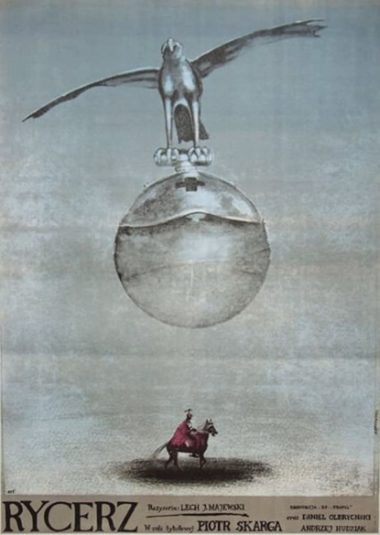 29. THE KNIGHT (RYCERZ)
29. THE KNIGHT (RYCERZ)
This film is either some kind of masterpiece or a huge load of pseudo artistic crap. An early effort by Poland’s Lech Majewski, it’s an incredibly arty and affected account of a medieval knight in search of a golden harp that’s supposed to bestow happiness upon whoever possesses it. The knight’s quest brings him into contact with a number of eccentric folk, and at one point he catches some kind of flesh eating disease that he inevitably passes onto someone else. Eventually there’s a beachfront orgy of sorts, followed by a deeply odd expression of what might be spiritual devotion. It’s shot entirely through fixed camera tableaux-styled compositions a la Sergei Paradjanov, although such a comparison would be giving Majewski far too much credit. The word for THE KNIGHT is striking, and I’ll leave it at that.
28. THE CHILD WOMAN (LA FEMME ENFANT)
 A French made love story that occurs between an elderly mute recluse (Klaus Kinski) and a lonely young girl (Pénélope Palmer) in a rural country milieu. No, you pervs, it’s not LOLITA, but rather a tender and poetic PG rated reverie that is, ultimately, deeply sad. Kinski delivers one of his most uncharacteristically subdued performances (even though he’s said to have been a “nightmare” on set) in a film that matches his efforts in its highly observant, non-salacious air. The script could perhaps be a bit more varied in its narrative development, as it does admittedly grow a bit monotonous, but the film overall works. FYI, a similarly oriented film, the Spanish THE NEST/EL NIDO, was also released in 1980, but it isn’t nearly as strong as THE CHILD WOMAN.
A French made love story that occurs between an elderly mute recluse (Klaus Kinski) and a lonely young girl (Pénélope Palmer) in a rural country milieu. No, you pervs, it’s not LOLITA, but rather a tender and poetic PG rated reverie that is, ultimately, deeply sad. Kinski delivers one of his most uncharacteristically subdued performances (even though he’s said to have been a “nightmare” on set) in a film that matches his efforts in its highly observant, non-salacious air. The script could perhaps be a bit more varied in its narrative development, as it does admittedly grow a bit monotonous, but the film overall works. FYI, a similarly oriented film, the Spanish THE NEST/EL NIDO, was also released in 1980, but it isn’t nearly as strong as THE CHILD WOMAN.
27. THE NIGHTMARE NEVER ENDS (CATACLYSM; SATAN’S SUPPER)
(CATACLYSM; SATAN’S SUPPER)
This micro-budgeter is one of the most cosmically inept horror movies of all time, with an unspeakably convoluted Philip Yordan script that violates every rule extolling the virtues of simplicity. Let’s see: there’s a Nazi gathering where a bunch of prisoners get mowed down, an old Jewish guy (apparently a descendant of said gathering) looking to hunt down the antichrist, a female surgeon (played by what has to be the single worst actress on Earth) suffering from nightmares, a writer who pens a tome called GOD IS DEAD, a theologically-minded bum and the Devil himself. The narrative has so many detours it’s nearly impossible to follow, but I found it fascinating nonetheless (it’s certainly not lacking in ambition). I’m also fascinated by the colossal ineptitude of the whole project; this monstrosity went through THREE directors, none of whom apparently knew what the Hell they were doing. The pic was later cut down severely for inclusion in the anthology film NIGHT TRAIN TO TERROR, but deserves to be experienced in its full mind-boggling form.
26. MACABRE (MACABRO)
A pretty good directorial debut from Italy’s Lamberto Bava that mixes perverse eroticism with atmospheric mystery. It’s about a woman who keeps her lover’s severed head in a freezer after he’s decapitated in a car accident. She takes it out each night and has sex with it, a fact we don’t find out about until near the end of this slow-building, suspenseful film. In that way it’s a bit like a Pupi Avati movie, which shouldn’t surprise anyone, as Avati co-wrote the script. His skill is evident throughout, and the seductive Bernice Stegers is quite fine in the lead role, rendering her character’s unnatural desires horrifically convincing. I just wish there weren’t so many standard Italian horror movie annoyances—cacophonous music, poorly dubbed dialogue (complete with fake southern accents), a goofy supernatural finale—that keep this otherwise impeccable film from achieving greatness.
 25. MAN AND PINE TREE (MEES JA MAND)
25. MAN AND PINE TREE (MEES JA MAND)
From a purely visual standpoint this film, a highly experimental quasi-documentary from Estonia’s Jaan Tooming (of the avant-garde classic ENDLESS DAY), is a near-masterpiece. The problem, from my standpoint, is that (as of 2021) no subtitled version exists, so I couldn’t tell what was going on. From what I’ve read it’s about a suicidal man returning to his hometown to end things, but all I discerned were a lot of stunningly achieved depictions of urban Estonia, visualized more often than not through fisheye lenses and highly mobile camerawork. What we see has a distinctly unsettled air, with sad-looking people situated amid partially constructed and/or demolished buildings, in addition to much overtly surreal imagery. It all makes for a fascinating KOYAANISQATSI-esque montage, although I’m not entirely sure that was Tooming’s intention.
24. CSONTVARY
This crazed exercise in experimental biography was the second and last feature by Hungary’s late Zoltan Huszarik. It doesn’t approach the brilliance of Huszarik’s first feature, the stunning SZINDBAD (1971), but I can’t say CSONTVARY isn’t compelling, and even brilliant, in its way. The film was apparently conceived as a straight biography of the Hungarian painter Csontvary Kostka Tivadar, to be played by actor Zoltan Latinovitsj. However, the latter committed suicide before filming began, so Huszarik reformatted the film as a dual biopic of both Csontvary and Latinovitsj. As such it freely leaps back and forth in time, often (deliberately) confusing the two periods, with the same actor (Itzhak Finzi) playing both roles. It’s rarely ever comprehensible, presenting us with a constant barrage of surrealism that often edges into outright absurdity.
23. FROM THE LIFE OF THE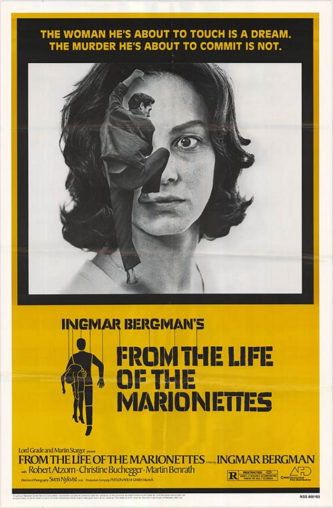 MARIONETTES (AUS DEM LEBEN DER MARIONETTEN)
MARIONETTES (AUS DEM LEBEN DER MARIONETTEN)
A sequel of sorts to SCENES FROM A MARRIAGE (1974), this Ingmar Bergman psycho-thriller pivots on a supporting player from that film, one Peter Egermann (Robert Atzorn), who impulsively strangles a prostitute and then violates her corpse. We hear from Egerman’s cold and calculating psychiatrist, his slutty wife, his mother and a gay man who was none-too-secretly besotted with Peter, all of whom profess shock at his actions–although flashbacks reveal that he was suffering rather severe depression in the days leading up to the killing. The dialogue heavy proceedings make extensive use of dreams, which take place over featureless white backgrounds and have a profoundly eerie resonance. Mirrors also play a large part in Bergman’s visual design, indeed perhaps a bit too much—subtle this film isn’t. I could have also done without the final monologue by the psychiatrist, which too-neatly sums up Peter’s psychological issues. Offsetting those negatives is the cinematography by the great Sven Nykvist, who visualizes the majority of the film in black and white that turns to lurid primary color in the opening and closing scenes.
22. UNION CITY
The granddaddy of the 1980s neo-noir craze, which came to include BLOOD SIMPLE and BLUE VELVET. UNION CITY is not in the same league as those masterworks, but it is arrestingly stylish. Adapted from Cornell Woolrich’s 1937 story “The Corpse Next Door,” it’s a Depression set downer involving a harried businessman (Dennis Liscomb) who becomes obsessed with catching the individual who’s been surreptitiously drinking the milk delivered to his apartment, all the while neglecting his sexy wife (Deborah Harry). Eventually Liscomb catches the milk drinker, a young man he inadvertently kills, and stashes the corpse in the murphy bed of a vacant apartment. From there Liscomb literally goes mad with guilt and paranoia (albeit not quite as harrowingly as in the story), leading to an ending that’s none too happy. Noteworthy elements include the incredibly garish color-coded lighting (bright red being the dominant hue) and highly arch, mannered performances—an approach that especially benefits non-actors like Harry and fellow pop star Pat Benatar. The script, for its part, could have been a bit more eventful; as is often the case with feature films adapted from short stories, it feels quite uneventful and protracted, being much ado about very little.
 21. MODEL
21. MODEL
This doco is often dismissed as a lesser effort by the great Frederick Wiseman, but I say it’s worthwhile. Lensed in grainy black and white, it accomplishes exactly what it promises, illuminating the inner workings of the modelling industry—and, by extension, late 20th Century America’s increasingly shallow, appearance-oriented drift—as presented via a New York talent agency whose clients are seen posing for print ads, TV commercials and a runway show. We’re also shown prospective models subjected to criticism about their appearance (with the major obstacle facing women, it seems, being not weight but height, about which photographers are apparently very exacting), taken to task by a temperamental commercial director and goofing around during a raucous photo shoot. The film admittedly lacks the laser-sharp focus of Wiseman’s best work; truth be told, MODEL is as much about NYC in the late 1970s as it is about modelling, which lends the film a time capsule charm it didn’t initially possess.
20. INSIDE MOVES
Director Richard Donner’s little-seen follow-up to SUPERMAN: THE MOVIE was this decidedly uncharacteristic drama, which is low key and offbeat in a most un-Donnerish manner. It stars John Savage as a former sports star who after jumping out of a building in a failed suicide attempt (a scene Donner recreated in LETHAL WEAPON) strikes up a friendship with David Morse as an injured basketball player turned bartender. As scripted by Barry Levinson and Valerie Curtin, the film is appealingly understated and character driven, and avoids clichés for the most part. Savage and Morse’s respective roads to recovery are appropriately bumpy and setback-filled, as is the halting romance Savage strikes up with Diana Scarwid as a troubled waitress. Only a few overly literal inspirational speeches toward the end, and a tacked-on bit in which a supporting player gets his comeuppance (which Donner has admitted wasn’t in the script), detract from the staunchly naturalistic, refreshingly un-Hollywood vibe.
19. THE BEASTS (SAN GAU)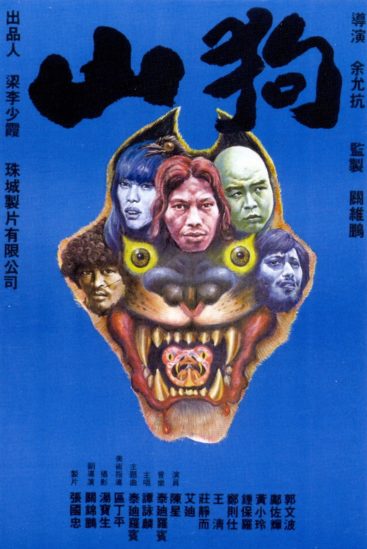
Often referred to Hong Kong’s answer to LAST HOUSE ON THE LEFT, this is a potent blast of action-oriented nastiness. It involves a group of horny young folk on a wilderness hike who run into a band of amoral scumbags, leading to gang rape, beatings, urine drinking and panty sniffing…until the rape victim’s father enters the fray to enact revenge. THE BEASTS is very much a product of the Hong Kong exploitation movie industry, meaning you can expect an oft-incoherent narrative packed with shameless overacting and choppy editing in addition to the expected breakneck action. Yet there are also some genuinely inspired bits of narrative dementia, such as a man digging up the parts of a dismembered corpse and leaving them to be gnashed on by pooches.
18. SCREAM FOR VENGEANCE
Watching the early scenes of this sexploiter, you can be forgiven for thinking, given the grungy big city milieu and queasy rape scenes, that you’re watching a porno “roughie” a la FORCED ENTRY (1973). After about twenty minutes, though, the pic switches gears dramatically, becoming a brutal kidnapping thriller a la THE CANDY SNATCHERS, only to morph yet again, into a wilderness-set pursuit that’s straight out of RITUALS. In short, this is a film with something for everybody, not unlike a grindhouse greatest hits compilation. Even the cut-rate production values, which all-but shout out the lowness of the budget, work to the film’s advantage, amplifying its seventies-sploitation aura.
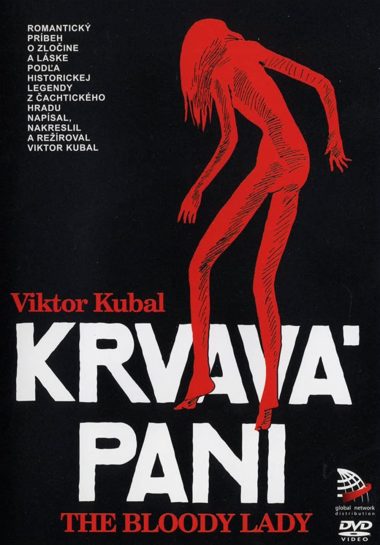 17. THE BLOODY LADY (KRVAVA PANI)
17. THE BLOODY LADY (KRVAVA PANI)
As idiosyncratic a take on the figure of Erzsbet Bathroy, the Hungarian “Blood Countess” who allegedly bathed in the blood of hundreds of virgins, as any you’ll find. THE BLOODY LADY is an animated feature from Czechoslovakia that apart from some brief opening narration is entirely dialogue-free. It begins in idyllic fashion, depicting Erzsbet B. as a carefree maiden living amid singing animals; in this happy atmosphere she falls in love with a forest-dwelling blonde guy to whom she (literally) gives her heart. But he breaks off the relationship, and a devastated Erzsbet falls under the spell of a shifty Rasputin wannabe who enables the Countess’ madness and disposes of her victims, killed by spears that jut out from her breasts. But her first love still has a thing for her, and heads to the castle to take on the evil figure—and, unlikely enough, redeem Erszbet’s crimes. The animation is quite dated, being highly minimalistic and somewhat primitive by today’s standards. It’s hard to judge whether writer-director Viktor Kubal was successful in his aims, although he has at least provided a mighty intriguing effort.
16. SOLO
With this, one of his earliest films, Russian maestro Konstantin Lopushansky created a potent 29-minute distillation of the themes explored by his subsequent masterworks LETTERS FROM A DEAD MAN and VISITOR OF A MUSEUM. Lensed in hazy black and white, SOLO is set in Leningrad during the 1942 blockade. Shell-shocked survivors huddle together in ravaged shacks while occasionally foraging in the bleak snow-bound world outside, with the gloom eventually broken by a ragtag orchestra performed for an audience of one. Overseen by Andrei Tarkovsky (for whom Lopushansky worked as a production assistant on STALKER), SOLO showcases a unique filmmaking sensibility in full bloom. The art direction is impressive and disturbingly convincing, as is the mood of poetic despair, which is something only Lopushanksy could pull off.
15. DIVA IN THE NETHERWORLD (UTAHIME MAKAI O YUKU)
(UTAHIME MAKAI O YUKU)
A Japanese kitsch fest about a young woman singer who together with a friend is involved in a taxicab accident that lands both of them in Hell. This Hell, however, isn’t like any other you’ve seen, being situated in a surreal hotel room setting run by a shrewish woman, while outside dinosaurs roam. Bloodlust is a daily fact of life in this place, as is cannibalism, all of it overseen by the devil himself. The film’s campiness and artificiality seem entirely intentional on the part of the filmmakers, whose aims were comedic in nature. Yes, it sounds like precisely the sort of thing I normally abhor, but this film has an irrepressibly wild, go-for-broke spirit reminiscent of Nobuhiko Obayashi’s legendary HOUSE.
14. TEMPTATION ISLAND
A Filipino film with such a gloriously batty premise one wonders why nobody else ever thought of it: four beauty pageant contestants and their male escorts, on a sea trip to California, wind up stranded on a desert island. Obviously things get very hairy very quickly, with seduction, catfights, desperation and even cannibalism making their presence felt. Deep and/or profound viewing this film isn’t, but it clearly thinks it is, which explains the insanely sappy coda in which the gals, rescued from the island, explain to TV audiences the Important Life Lessons they’ve learned with nary a trace of irony. It all adds up to a glorious chunk of celluloid camp that’s marred only by its opening twenty five minutes, which are seriously dull. But once the ocean liner on which the protagonists are being transported catches fire and blows up (conveyed via some of the most hilariously primitive conflagration effects in screen history) the hilarity really gets going, and continues through the final moments.
 13. SPETTERS
13. SPETTERS
A solid early effort by Paul Verhoeven, an episodic drama about the harsh lives of three Dutch bikers and a hot French fry vendor (the truly incandescent Renee Soutendijk) with whom the guys are obsessed. The film boasts solid acting and direction, sure, but SPETTERS’ main selling point (and the primary reason it was an arthouse hit) is its rawness, with depictions of extreme brutality, penis measuring, rape, suicide and enough sexual innuendo to fill a dozen Farrelly brothers comedies. It’s no surprise that at least one special interest group in its native Holland was formed specifically to protest this fast, trashy and ultimately quite entertaining film.
12. THE MUSIC OF ERICH ZANN
Easily the finest H.P. Lovecraft inspired short I’ve seen. The story, about a man who moves into a building where the mysterious Erich Zann plays weird music each night, is my favorite of HPL’s, and writer-director John Strysik does an excellent job adapting it to the screen, with gorgeous cinematography, a profoundly ominous atmosphere and an unforgettably trippy 2001-esque finale. It was a student film, and suffers from many of my standard student film grievances (including a number of dead spots and under lit visuals), but THE MUSIC OF ERICH ZANN is still a stunner.
11. WERNER HERZOG EATS HIS SHOE
SHOE
The famed documentarian Les Blank has always had an interest in Werner Herzog, one of the world’s greatest, and nuttiest, filmmakers. Blank’s 20 minute documentary WERNER HERZOG EATS HIS SHOE is probably the single most concise portrayal of the man (and his unerring flair for self-promotion) in existence. It records Herzog cooking and eating one of his boots before a captive audience at the 1979 Cannes Film Festival. Apparently he promised the filmmaker Errol Morris he’d do just that if the latter’s long-gestating documentary GATES OF HEAVEN (1978) was ever completed—which it was, forcing Herzog to make good on his pledge. With its Cajun Music soundtrack and black-humored clips of Charlie Chaplin scarfing a licorice boot, quite a lot of Blank’s own distinct personality shows up in a film that unites three great filmmakers—Blank, Herzog and Morris—in an unforgettably idiosyncratic concoction.
10. LARISA
This 20 minute documentary by Russia’s Elem Klimov is ostensibly about the life and achievements of his film director wife Larisa Shepitko, who was killed in a car accident in 1979. In actuality, though, LARISA’S subject is Klimov’s overpowering grief at her passing, which is what registers most strongly. Included are brief interviews with a few of Shepitko’s collaborators and clips from her films, including the justly famous hanging sequence from THE ASCENT (1977) and the final footage she shot for the film FAREWELL (which Klimov completed in 1983), but where LARISA really shines are in the more impressionistic sequences, with close-up stills of Shepitko assuming center stage in montages that fully showcase Klimov’s absolute mastery of the form.
 9. TIS PITY SHE’S A WHORE
9. TIS PITY SHE’S A WHORE
Jacobean drama makes for a good fit with British television, as demonstrated by the impressive 1972 BBC dramatization of THE DUCHESS OF MALFI. The later BBC production TIS PITY SHE’S A WHORE, adapted from John Ford’s 1633 tragedy by future Hollyweird bigshot Roland Joffe, is even better. It transposes the drama from Italy to Victorian England, and (the archaic dialogue aside) the updating works quite well. A debauched variant on ROMEO AND JULIET, it begins with an obsessed young man (Kenneth Cranham) professing incestuous desires for his sister (Cherie Lunghi), who actually shares his passions but is set to be married to a dashing suitor (Anthony Bate). Poisoning, infidelity, intrigue and (of course) incest are the order of the day in a drama that effectively utilizes natural lighting, which gives the visuals an appropriately harsh, unburnished sheen. Even more affecting are the changes Joffé and his collaborators made to the narrative, including an ending that’s far bleaker than what John Ford offered; the bad guys win out here, adding a Thatcher-era political dimension to a play that otherwise shows its age all too well.
8. BABYLON
It’s quite refreshing to see an edgy British film from the eighties that isn’t headlined by gangsters or skinheads. BABYLON has an arc similar to that of Spike Lee’s DO THE RIGHT THING, beginning as a funky, seriocomic portrait of the lives of a band of young black men, and gradually morphing into something far darker and more impacting. The protagonist is Blue (Brinsley Forde), an aspiring musician who together with his pals faces racism and exclusion on the gritty streets of South West London. Director Franco Rosso and cinematographer Chris Menges capture the nuances of their protagonist’s life, marked by drugs, cigarettes and ever-present reggae music, with impressive exactitude, and show just how it is that the surrounding strife, in the form of noisy neighbors and abusive cops, gradually pushes Blue over the edge in a finale so upsetting it reportedly got the film banned from the 1980 New York Film Festival.
7. DANGEROUS ENCOUNTERS OF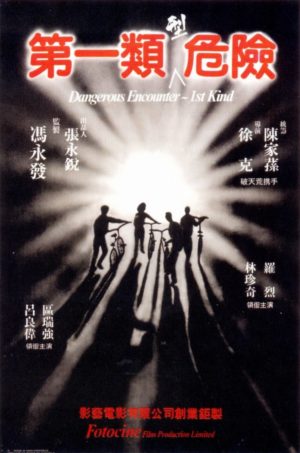 THE FIRST KIND (DI YI LEI XING WEI XIAN)
THE FIRST KIND (DI YI LEI XING WEI XIAN)
Easily the bleakest and most psychotic film ever made by Hong Kong’s Tsui Hark. In a nightmarish environ of petty theft and random violence, three joyriding teens run down an old man one night and immediately drive off—it’s anything but a clean getaway, however, as a sociopathic young woman witnesses the accident, and leads the boys into an increasingly horrific maelstrom of amorality and bloodletting. Tsui Hark’s aims here were apparently political in nature, yet the film has the same ultra-kinetic style of his more commercial offerings, albeit with a consistently harsh and unpredictable edge. It’s a measure of the film’s toughness that the one major female character, played by the attractive Lin Chen Chi, is the most dangerous and unpleasant of the entire lot—although Hark is careful to show that her psychosis stems from the utter hopelessness of her environment.
6. DEMON LOVER DIARY
This may well be the finest Making-of documentary ever, and certainly the most outrageous; not too many such films end with the filmmakers literally fleeing for their lives! THE DEMON LOVER (1976) is a thoroughly inept P.O.S. co-directed by the late bad movie guru Donald Jackson (who would go on to subject the world to ROLLERBLADE and HELL COMES TO FROGTOWN). Joel DeMott, the girlfriend of TDL’s cinematographer Jeff Kreines, decided to bring a camera along to document the behind the scenes drama, and the result was DEMON LOVER DIARY. It seems that Jackson financed TDL by scamming money out of his insurance company via an on-the-job “accident,” although that didn’t stop him from having to mortgage his house to get the film completed. Jackson’s complete lack of filmmaking expertise was another factor in his ultimate downfall, leading to endless bickering from his crew and a final meltdown at the home of rock ‘n roll provocateur Ted Nugent, where Jackson actually fired a gun at Kreines and DeMott, who were quick to hit the open road. It’s easy to laugh at Jackson and co.’s clumsiness, but anyone who’s ever worked on a low-budget production will recognize the grueling hours, the oft-fatal clashing of egos and the overall lack of organization on display, with DeMott’s crude home-movie aesthetics serving to enhance the experience—this film truly is the “Diary” promised by the title.
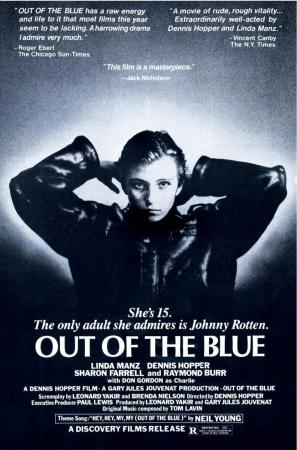 5. OUT OF THE BLUE
5. OUT OF THE BLUE
A great film to watch if you’re down on your luck, because regardless of how shitty your life may seem, it can’t possibly be worse than that of this film’s protagonist. CeBe (the late Linda Manz) is a fifteen-year-old girl undergoing a VERY painful transition to adulthood. Her loser father (Dennis Hopper) is in jail and her mom (Sharon Farrell) is a weak-willed heroin addict. CeBe tries to run away but an asshole lawyer (Raymond Burr) forces her back, just as daddy is released from prison to amply demonstrate why he was put there in the first place, and set the stage for an astonishingly bleak finale. The director was Dennis Hopper, who despite some John Cassavettes-like indulgences does what may be his finest work behind the camera. The film is intelligent, truthful, uncompromising and brilliantly acted, particularly by the amazing Ms. Manz, just 18 at the time and delivering one of the decade’s finest performances.
4. NIGHT OF THE JUGGLER
This high-profiler has been called the “the sleaziest movie ever released by a major studio,” and I’ll have to concur. It had a troubled history, having commenced filming in 1978 under the direction of Sidney J. Furie, who was replaced after 23 days by the veteran TV hack Robert Butler. James Brolin plays an ex-cop whose young daughter is kidnapped in Central Park by a scumbag (Cliff Gorman), resulting in an epic chase that entails numerous fistfights, car crashes, shoot-outs and, perhaps most shocking of all to modern viewers, a great deal of politically incorrect dialogue. The narrative is perilously thin, but Butler and/or Furie make up for that with a superbly picturesque evocation of New York City at the end of the 1970s. You simply won’t find a more richly textured depiction of the city’s grittier environs, which include a Times Square peep show emporium (whose interior was admittedly created on a soundstage) and a subway tunnel where the brutal climax occurs. Kudos, also, to the impeccably chosen cast, starting with the lead actors James Brolin, Cliff Gorman and Dan Hedaya, all of whom blend in seamlessly with the overall atmosphere of big city seediness.
3. BLACK ANGEL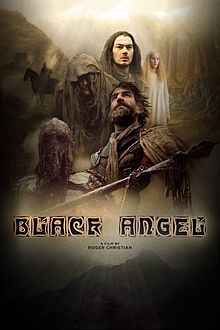
This George Lucas financed short played before THE EMPIRE STRIKES BACK during its initial release in England and Australia. Filmed in the Western Highlands of Scotland by writer-director Roger Christian, BLACK ANGEL is set in the middle ages, wherein a heroic knight is faced with death, disease, a fetching young maiden and a horrific creature. BLACK ANGEL is first and foremost a visual stunner with a teasingly hallucinatory air that’s equally impressive. Credit must go to cinematographer Roger Pratt, art director John Beard and composer Trevor Jones, whose respective artistry is integral to the impact of a film that may have been a low budget affair but plays like a big screen spectacular.
2. THE FALLS
Peter Greenaway’s first feature may very well be his greatest-ever film. It’s an astonishing three-hour mock documentary purporting to be an inquiry into the effects of the VUE (or Violent Unknown Event), an occurrence that apparently took place over the course of a single night and had something to do with birds. Manifestations of the event include physical deformities (such as the growth of wings), an obsessive interest in all things ornithological and allergic reactions to the color red. The proceedings take the form of 92 mini-bios of VUE victims whose last names all begin with “Fall,” related primarily through still photographs, 16mm footage and hilariously monotone BBC-style narration. And let’s not forget Michael Nyman’s absolutely superb score (which—dammit—is still not available in CD or mp3 formats). At once a parody, science fiction reverie, epic experiment and oblique commentary on early 1980s Britain, THE FALLS remains utterly unique.
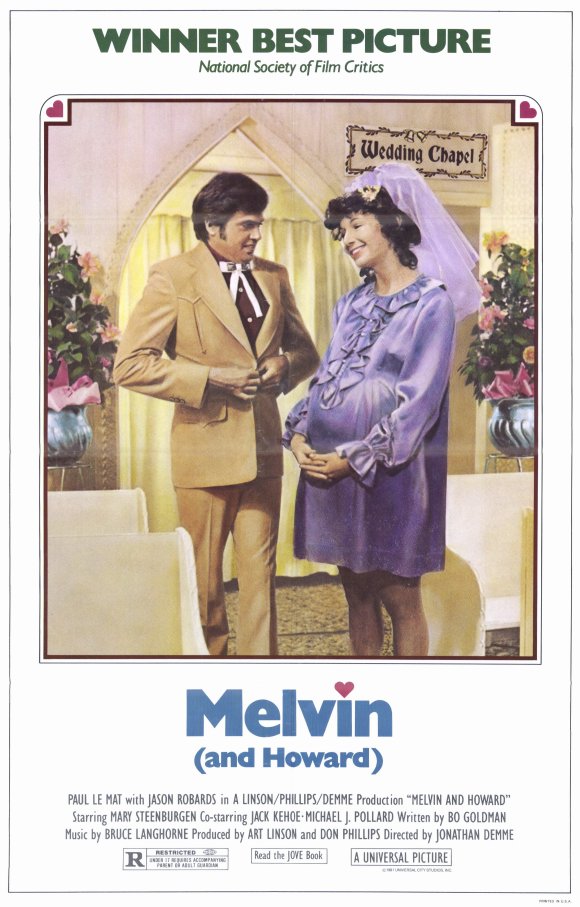 1. MELVIN AND HOWARD
1. MELVIN AND HOWARD
The late Jonathan Demme’s supreme masterpiece. MELVIN AND HOWARD is the fact-based story of the late Melvin Dummar, a working-class drudge who gave an ailing Howard Hughes a ride one night, and later produced a lucrative will purporting to be written by H.H. himself. Demme and screenwriter Bo Goldman are more interested in Melvin’s day-to-day life than the details of said will; if this film is to be believed (a postscript assures us it was shot in locations “where the events actually occurred”) he initially lived in a trailer with his stripper wife until she won ten thousand dollars on a game show and he blew most of it on a new car. Working as a milkman, Melvin shacked up with a co-worker and they moved to Utah to run a gas station she inherited. It was here that a mysterious guy in a suit showed up one day (or so Melvin claimed) and left the will. An unassuming yet quite mesmerizing film, buoyed by great performances from Paul LeMat, Mary Steenburgen and Jason Robards as Mr. Hughes, whom Melvin, an amateur songwriter, gets to sing one of his own compositions (written by the real M. Dummar). A veritable epic of Americana, this is the type of fare many people say Hollywood should make more of, even though such films hardly ever work once they reach the screen. MELVIN AND HOWARD is the exception.
